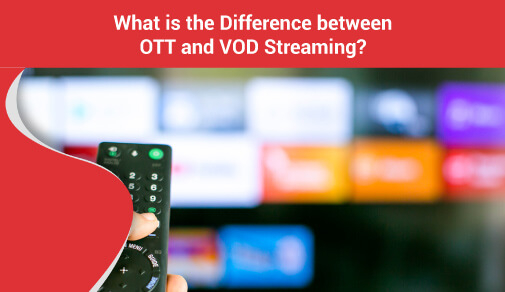What is the difference between OTT and VOD Streaming?
Sunday, Oct 06, 2024 · 5 minutes


OTT
Sunday, Oct 06, 2024 · 5 minutes
In the digital era, traditional television is yielding to cable and satellite options, alongside innovative forms of content delivery like OTT (Over the Top) and VOD (Video on Demand). These technologies empower viewers by offering on-demand access to diverse content. Here, we explore what is OTT and VOD streaming, highlighting the difference between OTT and VOD. Looking ahead, we discuss future trends in the entertainment industry, particularly with ACT Fibernet, and review the best ACT broadband plan with an OTT subscription.
OTT is short for Over-The-Top, which is a method of using the internet to transmit audio, video, or other content, excluding conventional means like Cable and Broadcast TV and Satellite TV. OTT services offer users the content on an application or a web page on several devices: a smartphone, a tablet, a smart TV, or a computer.
VOD entity expands with Video on Demand, a distribution of media content through which the consumer relies to watch video content. A primary difference is that while broadcasting has restrictions on time, for instance, one has to watch a particular show at some particular time in the day, VOD enables users to select and view content whenever they choose. VOD content can be accessed via the internet, as well as through cable and satellite providers.
OTT: Relates it specifically to the transmission of content over the Internet instead of the more common cable and satellite systems. OTT services can be of various forms, such as Live Streaming Services, Subscription Video Demand Services, Advertising Video Demand Services, and Pay-Per-View Video Demand Services.
VOD: Over the top refers to the mode of access to content delivered through the internet or traditional service providers. VOD, thus, places much importance on the discretion of watching videos on demand.
OTT: Exclusively uses the internet for content delivery. Examples include Netflix, Hulu, and Amazon Prime Video.
VOD: This can be delivered over the internet or through cable and satellite networks. Examples include cable on-demand services and digital rentals or purchases.
OTT: Often includes a mix of live content (like live sports or news) and on-demand content. Some OTT services offer both live TV and on-demand libraries.
VOD: Primarily focuses on on-demand content, allowing users to select and watch specific titles at their convenience.
OTT: This can be subscription-based (SVOD), ad-supported (AVOD), or transactional (TVOD). It provides flexibility in how users can access and pay for content.
VOD: Typically aligns with one of the OTT business models but is specifically characterized by the on-demand nature of the content. This means users can start, stop, and resume content as they wish.
OTT and VOD player of India ACT Fibernet is going to contribute significantly because it is providing high-speed broadband services, which are being increasingly sought by streaming players. ACT Fibernet offers combo broadband plans that include subscriptions to streaming apps, which makes it easier for users. This integration helps deliver the best streaming to consumers, making ACT Fibernet one of the best broadband service providers.
ACT Fibernet offers excellent broadband plans with OTT subscriptions, which are perfect for various user needs.
OTT and VOD streaming present new ways of watching media, with great flexibility and choice and the prime convenience element. In contrast to OTT, which reflects the online delivery method, VOD hinges on the convenience of watching the content on one's schedule.
ACT Fibernet is also leading this revolution with its high-speed internet plans that are likely to suffice modern customers' demands. ACT Fibernet ensures that users can enjoy a seamless and high-quality streaming experience, making it one of the best choices for broadband for streaming. To get the best internet speed for streaming and ensure you have the recommended internet speed for 4K streaming, consider opting for an ACT broadband plan that meets your needs.
55

The New Social: How High-Speed Internet is Redefining 'Quality Time' with Friends and Family
Read more172

How ACT SmartWi-Fi is Redefining Home Internet in 2025: The Age of AI-Powered Seamless Connectivity
Read more87

From Bandwidth to Intelligence: How AI Is Redefining Business Demands from ISPs
Read more
A referral link has been sent to your friend.
Once your friend completes their installation, you'll receive a notification about a 25% discount on your next bill
![]() Please wait while we redirect you
Please wait while we redirect you

![]() One of our representatives will reach out to you shortly
One of our representatives will reach out to you shortly

One of our representatives will reach out to your shortly
![]() Please wait while we redirect you
Please wait while we redirect you

Please enter your registered phone number to proceed

Please enter correct OTP to proceed


Dear customer you are successfully subscribed
Please wait while we redirect you

Your ACT Shield subscription has been successfully deactivated

Dear user, Your account doesn't have an active subscription

Dear customer Entertainment pack is already activated.
Please wait while we redirect you